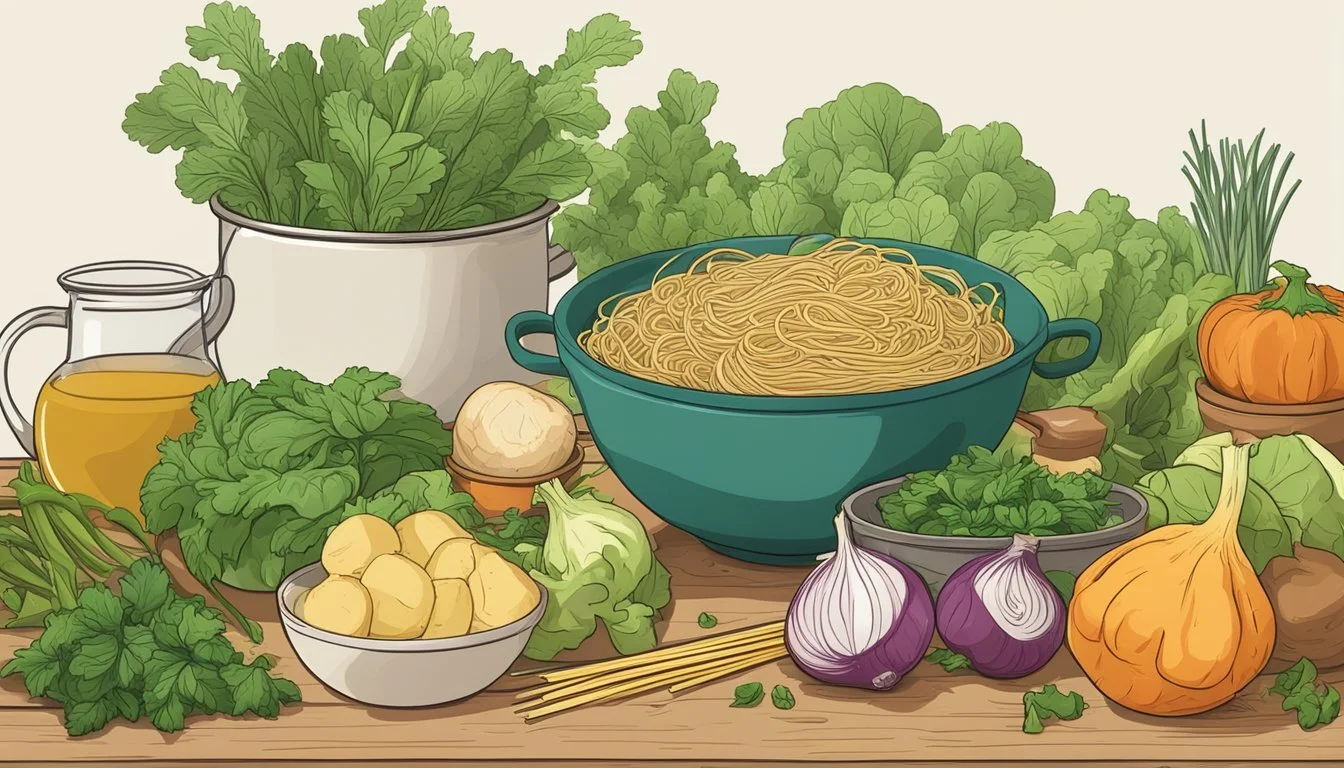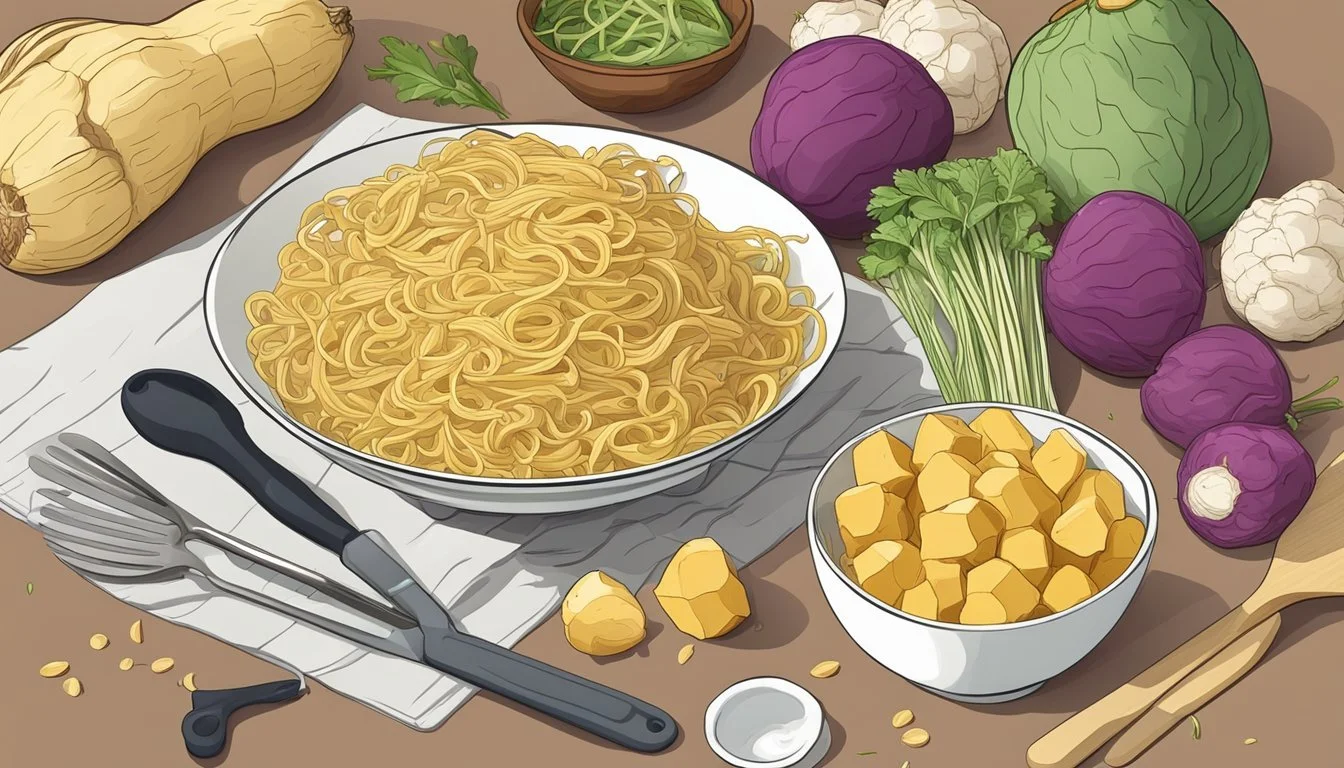Rutabaga Noodle Substitutes
Top Alternatives for Low-Carb Diets
Rutabaga, a root vegetable close relative to the turnip, offers a versatile profile in the kitchen, particularly when spiralized into noodles as a healthy alternative to traditional pasta. Its mildly sweet and earthy flavor provides an excellent base for a variety of dishes, making it a popular choice for those looking to infuse nutrition and variety into their meals. Due to its consistency and taste, rutabaga noodles serve as an apt canvas for sauces and toppings, aligning well with culinary trends that favor vegetable-centric dishes.
However, rutabagas might not always be available, or cooks might seek different flavors and textures to complement certain recipes, prompting the need for suitable substitutes. Within the realm of root vegetables, there are several alternatives that can mimic the qualities of rutabaga noodles. Turnips, kohlrabi, and parsnips are commendable replacements, each bringing their unique flavor profile and textural nuances to a dish. Turnips' similarity in texture to rutabagas makes them an almost seamless substitute, kohlrabi matches the heft and can withstand similar cooking methods, while parsnips offer a sweeter taste profile.
Identifying the ideal stand-in for rutabaga noodles depends on the desired outcome of the dish—be it the need to maintain a specific texture or to achieve a certain flavor profile. These alternative root vegetables can be spiralized, roasted, or mashed, providing flexibility and variety in kitchen preparations. They enable cooks to continue exploring the wealth of options within the world of root vegetables, ensuring that the absence of rutabaga does not limit culinary creativity.
Understanding Rutabaga
The rutabaga, often overlooked, is a versatile root vegetable with significant nutritional value and a distinct flavor that adds complexity to a range of dishes.
Culinary Uses of Rutabaga
Rutabaga can be a culinary chameleon in the kitchen. It's utilized in various forms—roasted, mashed, and even spiralized into noodles. Chefs incorporate rutabaga into salads for a crunchy element, or use it as a key ingredient in hearty stews where it contributes to the dish's overall substance and texture. Its ability to substitute for other root vegetables, like sweet potatoes, makes it a cherished ingredient among those who appreciate its unique qualities in mash or other preparations.
Nutritional Profile of Rutabaga
Nutritionally, rutabaga is a powerhouse, offering a wealth of benefits. Rich in vitamins C and E, fiber, and potassium, it's a root vegetable that can contribute positively to one's diet. The table below presents an overview of rutabaga's nutritional content:
Nutrient Amount per 100g Calories 38 Carbohydrates 8.62g Fiber 2.3g Protein 1.08g Vitamin C 25% DV Potassium 6% DV
Rutabaga's Flavor Profile
The flavor of rutabaga is often described as mildly sweet, with a taste that's subtler than that of a sweet potato. Its flavor profile makes it a flexible addition to both savory and sweet dishes. The texture of cooked rutabaga is pleasingly tender, yet it retains enough structure to offer variation in mouthfeel, enhancing the experience of the dish it's featured in.
Top Rutabaga Substitutes
When seeking an alternative to rutabaga noodles, one must consider the texture and flavor profile desired in the final dish. Here are some of the top substitutes categorized by type.
Root Vegetable Alternatives
Turnips: A classic replacement with a similar texture to rutabaga. They can be easily julienned into noodle shapes.
Carrots: Offer a sweeter taste and firm texture, that stands up well when spiralized.
Celeriac (Celery Root): Provides a unique, earthy flavor and retains a pleasant crunch when used as noodles.
Other Vegetable Substitutes
Zucchini: While not a root vegetable, it spiralizes into perfect noodles and offers a lighter, slightly sweet taste.
Sweet Potatoes: Another non-root option, sweet potatoes give dishes a sweet, hearty base with a soft texture after cooking.
Unconventional Substitutes
Kohlrabi: Its bulb can be turned into crunchy, nutrient-rich noodles.
Broccoli Stems: Often discarded, these can be turned into a fibrous and healthy noodle substitute.
Daikon Radish: A white radish that's milder than others, ideal for those who want a less peppery bite in their dishes.
Substituting Rutabaga in Recipes
When a recipe calls for rutabaga, its unique taste and texture play a key role in the dish. However, various vegetables can step in as suitable substitutes, maintaining a similar profile in salads, soups, baked goods, and mashed dishes.
Salads and Slaws
One can replace rutabaga with turnips in salads and slaws to preserve the dish's crunchy texture. They should be peeled, chopped, and used in a 1:1 ratio. Another alternative, jicama, offers a slightly sweet and nutty flavor, contributing a refreshing crunch to the dish.
Soups and Stews
For soups and stews, parsnips make an excellent substitute as they mirror rutabaga's earthy yet sweet flavor. Parsnips should be diced or sliced and can be added directly to boiling broths similarly to how one would incorporate rutabaga. When a softer texture is desired, carrots enhance the sweetness and provide a comforting feel.
Baked and Roasted Dishes
In baked and roasted dishes, rutabaga's absence can be filled by potatoes or sweet potatoes, offering a similar starchy body and ability to hold their structure under heat. For each pound of rutabaga, an equal weight of potatoes, cut into equivalent-sized chunks, will yield a compatible result in casseroles and roasted preparations.
Mashed Preparations
To achieve the creamy consistency of mashed rutabaga, one could opt for butternut squash or cauliflower. Both should be cooked until soft and then puréed or mashed to reach the desired smoothness. Butternut squash will add a hint of sweetness while cauliflower provides a lighter texture to the mash.
Selecting the Best Substitute
When looking for an alternative to rutabaga noodles, one should consider taste, nutrition, and availability to ensure the substitute aligns with the desired outcome of the dish.
Taste Considerations
The best substitutes for rutabaga noodles should have a comparable texture and flavor profile. For instance, turnips offer a similar taste and can be cut into noodle shapes easily. Another option is butternut squash, which provides a slightly sweet flavor and a dense texture that holds up well during cooking, resembling the heartiness of rutabaga noodles.
Nutritional Concerns
Rutabaga is known for its nutritional benefits, including high levels of potassium and dietary fiber. Substitutes like kohlrabi not only mimic the texture but also are a good source of these nutrients. For those monitoring carbohydrate intake, kohlrabi is lower in calories and carbohydrates, making it an ideal option while maintaining similar nutritional value.
Availability and Accessibility
One must consider the availability of substitutes at their local grocery store. Root vegetables like turnips and butternut squash are generally accessible and can be found at most grocery stores. They also hold a shelf-life that is comparable to rutabaga, making these substitutes practical for both immediate use and storage for later culinary creations.
Innovative Uses for Rutabaga Substitutes
Exploring rutabaga substitutes offers chefs and home cooks alike the chance to reinvent classic dishes, ensure dietary inclusivity, and embrace global flavors.
Fusion Cuisine Inspirations
Fusion cuisine thrives on the creative combination of culinary traditions. Asian-inspired dishes, for instance, can be transformed by substituting rutabaga noodles with alternatives like zucchini spirals or sweet potato noodles. These substitutes not only have a comparable texture but also absorb flavors well, making them ideal for stir fry applications. In incorporating fermented elements, which add depth and a hint of sourness, one balances the natural bitterness that some substitutes might possess.
Example Fusion Dish:
Sweet Potato Noodles Stir Fry: A vibrant mix of sauces typical of Asian cuisine paired with sweet potato noodles for a twist on traditional stir fry.
Vegetarian and Vegan Variations
Vegetable-based noodles are a cornerstone in vegetarian and vegan cooking. They pair excellently with a rich variety of plant-based ingredients. Chefs could recommend cauliflower rice or noodles as a rutabaga substitute, lending the dish a different texture but similar versatility. These options easily adopt the flavors of herbs and spices, making them suitable for a diverse array of recipes.
Highlight for Vegetarians:
Use cauliflower rice in a curry: It absorbs the aromatic curry spices and provides a nutritious base for a variety of vegetable toppings.
Low-Carb and Gluten-Free Options
Demand for low-carb and gluten-free diet options continues to rise. In response, chefs are using vegetable substitutes to craft dishes that cater to these dietary needs without sacrificing flavor. Substitutes such as zucchini, spaghetti squash, and turnip noodles present excellent low-carb and gluten-free alternatives to rutabaga noodles. These substitutions often have a mild flavor profile, allowing the spices and sauces of a dish to stand out.
Dietary Consideration Table:
Substitute Low-Carb Gluten-Free Texture Note Zucchini Spirals ✓ ✓ Holds up well to light sauces Spaghetti Squash ✓ ✓ Separate strands like pasta Turnip Noodles ✓ ✓ A bit of a crunch; less bitter




